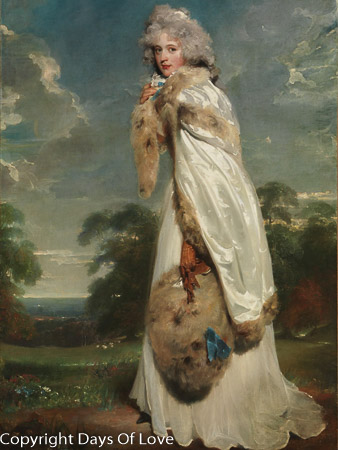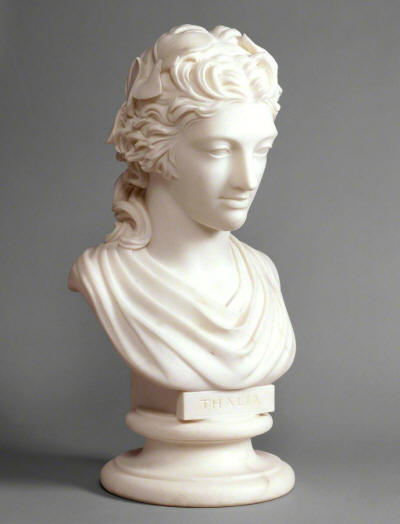Queer Places:
Knowsley Park, Knowsley, Prescot L34 4AG, UK
Ormskirk Parish Churchyard, Ormskirk, Regno Unito
 Elizabeth
Farren (c. 1759 – 23 April 1829) was an English actress of the late 18th
century. The renowned sculptor Anne Seymour Damer
was passionately in love with
Mary Berry,
who lived with her sister in Twickenham. Mary never allowed Anne’s
advances to stray beyond the preliminaries and kept her suitor at arm’s
length, as a friend only. Anne turned her attentions to actress
Elizabeth Farren,
the future Countess of Derby, and their affair was lampooned in
satirical street pamphlets, with ribald speculation that Anne did a lot
more for Elizabeth sexually than her husband ever could. Anne Seymour Damer was the
subject of a number of political satires in the XVIII century. After her
husband's death, she developed a close friendship with
Mary Berry
and her home in Strawberry Hill became associated with a sapphic set
including the actresses Kitty
Clive and
Elizabeth Farren.
One satire, entitles A Sapphic Epistle, by Jack Cavendish, referred to a
Mrs D...r and claimed: Strawberry Hill at once doth prove, Taste,
elegange, and Sapphic love, In gentle Kitty. Another referred to
Elizabeth Farren before her marriage to Lord Derby, observing: superior
to the influence of MEN, she is supposed to feel more exquisite delight
from the touch of the cheek of Mrs D...r, than the fancy of any
novelties which the wedding night can promise with such a partner as his
lordship.
Elizabeth
Farren (c. 1759 – 23 April 1829) was an English actress of the late 18th
century. The renowned sculptor Anne Seymour Damer
was passionately in love with
Mary Berry,
who lived with her sister in Twickenham. Mary never allowed Anne’s
advances to stray beyond the preliminaries and kept her suitor at arm’s
length, as a friend only. Anne turned her attentions to actress
Elizabeth Farren,
the future Countess of Derby, and their affair was lampooned in
satirical street pamphlets, with ribald speculation that Anne did a lot
more for Elizabeth sexually than her husband ever could. Anne Seymour Damer was the
subject of a number of political satires in the XVIII century. After her
husband's death, she developed a close friendship with
Mary Berry
and her home in Strawberry Hill became associated with a sapphic set
including the actresses Kitty
Clive and
Elizabeth Farren.
One satire, entitles A Sapphic Epistle, by Jack Cavendish, referred to a
Mrs D...r and claimed: Strawberry Hill at once doth prove, Taste,
elegange, and Sapphic love, In gentle Kitty. Another referred to
Elizabeth Farren before her marriage to Lord Derby, observing: superior
to the influence of MEN, she is supposed to feel more exquisite delight
from the touch of the cheek of Mrs D...r, than the fancy of any
novelties which the wedding night can promise with such a partner as his
lordship.
Both of Farren's parents were actors and as a child she acted with her
mother and sisters in juvenile parts. She first appeared on the London stage
in 1777 as Miss Hardcastle in She Stoops to Conquer and the following year
appeared at Drury Lane which, along with the Haymarket theatre became her
primary venues for the rest of her acting career. She had over 100 characters
in her repertoire including Shakespeare and various contemporary comedies and
dramas. She was often compared to Frances Abington, who was her only real
rival. Her last appearance was in April 1797, two months before her marriage
to Edward Smith-Stanley, 12th Earl of Derby. They had a son and two daughters.

Elizabeth, née Farren (1759–1829), Countess of Derby c.1788
Anne Seymour Damer (1748–1828)
National Portrait Gallery, London
On 1 May 1797 she married Edward Smith-Stanley, 12th Earl of Derby
(1752–1834) by whom she had a son and two daughters. She died on 23 April 1829
at Knowsley Park, Lancashire.
She had a short sentimental attachment to John Palmer and was admired and
followed by Charles Fox. Lord Derby reportedly treated her with more respect
than was sometimes given to ex-actresses. Hazlitt speaks of "Miss Farren, with
her fine-lady airs and graces, with that elegant turn of her head and motion
of her fan and tripping of her tongue" (Criticisms and Dramatic Essays,
1851, p. 49). Richard Cumberland (Memoirs, ii. 236) mentions her style
as "exquisite." George Colman the younger (Random Recollections, 1.
251) says of "the lovely and accomplished Miss Farren" that "No person ever
more successfully performed the elegant levies of Lady Townly." Tate Wilkinson
credits her with "infinite merit" (Wandering Patentee, iii. 42). Boaden
(Life of Siddons, ii. 318) says that after her retirement comedy
degenerated into farce.
Horace Walpole spoke of her as the most perfect actress he had ever seen,
and Mrs. Siddons, on the day of Farren's marriage, commiserated the loss of
"our comic muse."
My published books:


BACK TO HOME PAGE

- https://en.wikipedia.org/wiki/Elizabeth_Farren
- A Lesbian History of Britain: Love and Sex Between Women Since 1500,
Rebecca Jennings, Greenwood World Pub., 2007
- Rossini, Gill. Same Sex Love 1700-1957: A History and Research Guide .
Pen and Sword. Edizione del Kindle.
- Rupp, Leila J.. Sapphistries (Intersections) (p.115). NYU Press.
Edizione del Kindle.
 Elizabeth
Farren (c. 1759 – 23 April 1829) was an English actress of the late 18th
century. The renowned sculptor Anne Seymour Damer
was passionately in love with
Mary Berry,
who lived with her sister in Twickenham. Mary never allowed Anne’s
advances to stray beyond the preliminaries and kept her suitor at arm’s
length, as a friend only. Anne turned her attentions to actress
Elizabeth Farren,
the future Countess of Derby, and their affair was lampooned in
satirical street pamphlets, with ribald speculation that Anne did a lot
more for Elizabeth sexually than her husband ever could. Anne Seymour Damer was the
subject of a number of political satires in the XVIII century. After her
husband's death, she developed a close friendship with
Mary Berry
and her home in Strawberry Hill became associated with a sapphic set
including the actresses Kitty
Clive and
Elizabeth Farren.
One satire, entitles A Sapphic Epistle, by Jack Cavendish, referred to a
Mrs D...r and claimed: Strawberry Hill at once doth prove, Taste,
elegange, and Sapphic love, In gentle Kitty. Another referred to
Elizabeth Farren before her marriage to Lord Derby, observing: superior
to the influence of MEN, she is supposed to feel more exquisite delight
from the touch of the cheek of Mrs D...r, than the fancy of any
novelties which the wedding night can promise with such a partner as his
lordship.
Elizabeth
Farren (c. 1759 – 23 April 1829) was an English actress of the late 18th
century. The renowned sculptor Anne Seymour Damer
was passionately in love with
Mary Berry,
who lived with her sister in Twickenham. Mary never allowed Anne’s
advances to stray beyond the preliminaries and kept her suitor at arm’s
length, as a friend only. Anne turned her attentions to actress
Elizabeth Farren,
the future Countess of Derby, and their affair was lampooned in
satirical street pamphlets, with ribald speculation that Anne did a lot
more for Elizabeth sexually than her husband ever could. Anne Seymour Damer was the
subject of a number of political satires in the XVIII century. After her
husband's death, she developed a close friendship with
Mary Berry
and her home in Strawberry Hill became associated with a sapphic set
including the actresses Kitty
Clive and
Elizabeth Farren.
One satire, entitles A Sapphic Epistle, by Jack Cavendish, referred to a
Mrs D...r and claimed: Strawberry Hill at once doth prove, Taste,
elegange, and Sapphic love, In gentle Kitty. Another referred to
Elizabeth Farren before her marriage to Lord Derby, observing: superior
to the influence of MEN, she is supposed to feel more exquisite delight
from the touch of the cheek of Mrs D...r, than the fancy of any
novelties which the wedding night can promise with such a partner as his
lordship.

